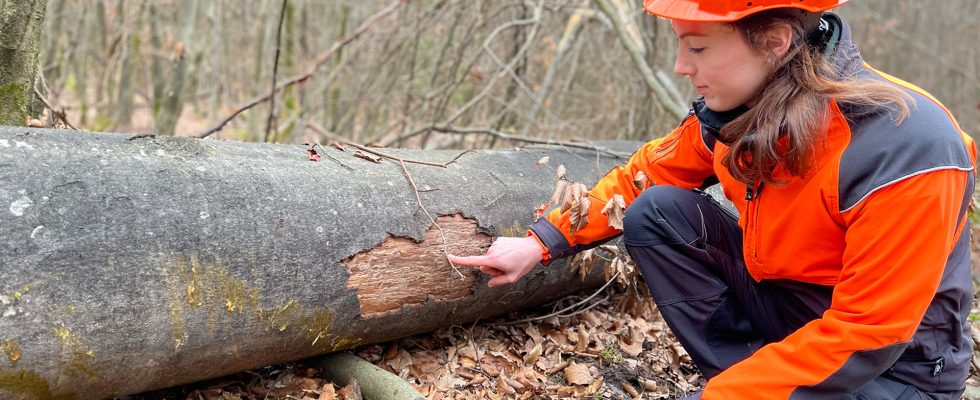Status: 04/02/2023 03:56
The German forests are in a disastrous condition. More and more trees are becoming ill due to drought and heat. A young forester tries to lead her territory through climate change using a mix of species.
Alina Kratofil begins to smile when she talks about the forest and her dream job as a forester – despite the enormous problems caused by climate change. “I really like being in the forest and moving in nature,” explains the 27-year-old tagesschau.de and even speaks of her “home”. But ever since the graduate forester became district manager in Hünfeld, Hesse, 6 months ago, worries about the forest stock have been her everyday life.
Damage limitation as the core task
“I actually only deal with calamities, i.e. areas where there are no more trees and damaged wood,” she reports. “So far, I’ve actually only known regular forestry from stories. At the moment, all of our young colleagues only know damage limitation or disaster,” says Kratofil. According to the latest forest condition survey by the Federal Ministry of Food and Agriculture, four out of five trees in German forests are diseased. “The forest is a patient that needs our help,” emphasized Federal Minister of Agriculture Cem Özdemir recently.
In their 1800-hectare area in the Rhön, Kratofil is trying to provide precisely this help. The timber harvest season is currently underway, the forester and her team have their hands full. While in other federal states, especially in the south of Germany, softwood in particular is suffering from climate change, beech is particularly affected in their area. Many crowns are so dry that the trees have to be felled as quickly as possible before their wood is no longer usable. “The situation is dramatic,” reports the forester.
Kratofil’s territory is suffering greatly from the drought of recent years.
Image: Joscha Bartlitz / HR
Hope also rests in nature itself
“Hesse is the beech country. The last dry summers, the heat, the little water – the old beeches can’t stand that,” says Kratofil. “We still have hope that the younger beeches will cope better with the drought.” She also relies on natural regeneration, i.e. new trees that grow back naturally from seeds that have fallen or been flown on and adapt better to the difficult conditions. “If there are gaps, we fill them in with other tree species,” explains the 27-year-old.
Nature is far from doing the reforestation itself everywhere, on the contrary. The largest clearing in Kratofil’s jurisdiction is two hectares – a hole in the forest the size of three soccer fields. A spruce monoculture fell victim to the drought, storm damage known as “windthrow” and bark beetle infestation. “In northern Hesse or other federal states, you can see that the bark beetle has won the fight. There have been an incredible number of open spaces that we are now reforesting,” says Kratofil. But even in nature, not everything always works according to plan.
Different types
The attempt to use oak trees for reforestation initially failed with Kratofil and her colleagues on this open space. They touched it up with maple, then red and sessile oak and hornbeam. “The larger the loss, the stronger you continue with another tree species,” reports forestry master Uwe Walter, who carries out the reforestation work.
“When we establish new forest, we always try to bring at least five tree species to the area in order to spread the risk across different tree species,” adds Kratofil. “We look for suitable tree species that have been scientifically proven to grow better here.”
A stable mixed forest for the future
The oak tree in particular is particularly resistant and is currently coping well with the drought, reports the forest manager on her experiences. But even the oak alone is not a panacea. The goal now is to “establish stable mixed forests and to bring a lot of tree species to the area,” says the forester. The mixture is also the key for the existing forest areas: “If there are other tree species in beech stands, such as oak, maple or cherry, then it is important that their care is encouraged so that they are preserved and the forest is more stable becomes.”
Even if it often feels like “a fight against windmills”, the forester remains optimistic even in the difficult times of global warming. She has a clear vision in mind: “I want to leave behind a stable and healthy forest for future generations. That’s what drives me.”

